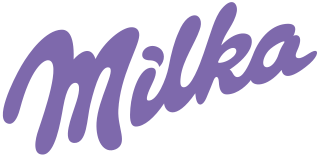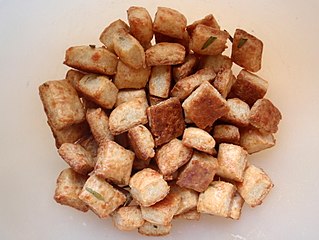
A cookie or biscuit is a baked snack or dessert that is typically small, flat, and sweet. It usually contains flour, sugar, egg, and some type of oil, fat, or butter. It may include other ingredients such as raisins, oats, chocolate chips, or nuts.

Oreo is a brand of sandwich cookie consisting of two cocoa biscuits or cookie pieces with a sweet fondant filling. It was introduced by Nabisco on March 6, 1912, and through a series of corporate acquisitions, mergers, and splits, both Nabisco and the Oreo brand have been owned by Mondelez International since 2012. Oreo cookies are available in over one hundred countries. Many varieties of Oreo cookies have been produced, and limited-edition runs have become popular in the 21st century.

The Keebler Company is an American cookie and former cracker manufacturer. Founded in 1853, it has produced numerous baked snacks, advertised with the Keebler Elves. Keebler had marketed its brands such as Cheez-It, Chips Deluxe, Club Crackers, E.L. Fudge Cookies, Famous Amos, Fudge Shoppe Cookies, Murray cookies, Austin, Plantation, Vienna Fingers, Town House Crackers, Wheatables, Sandie's Shortbread, Pizzarias Pizza Chips, Chachos and Zesta Crackers, among others. Keebler slogans have included "Uncommonly Good" and "a little elfin magic goes a long way". Tom Shutter and Leo Burnett wrote the familiar jingle.
Lunchables is an American brand of food and snacks manufactured by Kraft Heinz in Chicago, Illinois, and marketed under the Oscar Mayer brand. They were initially introduced in Seattle in 1988 before being released nationally in 1989. Many Lunchables products are produced in a Garland, Texas, facility, and are then distributed across the United States.

Milka is a Swiss brand of chocolate confectionery. Originally made in Switzerland in 1901 by Suchard, it has been produced in Lörrach, Germany, from 1901. Since 2012 it has been owned by US-based company Mondelez International, when it started following the steps of its predecessor Kraft Foods Inc., which had taken over the brand in 1990. It is sold in bars and a number of novelty shapes for Easter and Christmas. Products with the Milka brand also include chocolate-covered cookies and biscuits.

Sunshine Biscuits, formerly known as The Loose-Wiles Biscuit Company, was an independent American baker of cookies, crackers, and cereals. The company, which became a brand on a few products such as Cheez-It, was purchased by Keebler Company in 1996, which was purchased by Kellogg Company in 2001. Around then, Sunshine Biscuits was headquartered in Elmhurst, Illinois, where Keebler was located until 2001.

Kraft Foods Inc. was a multinational confectionery, food and beverage conglomerate. It marketed many brands in more than 170 countries. Twelve of its brands annually earned more than $1 billion worldwide: Cadbury, Jacobs, Kraft, LU, Maxwell House, Milka, Nabisco, Oreo, Oscar Mayer, Philadelphia, Trident, and Tang. Forty of its brands were at least a century old.

Nilla Wafers are vanilla-flavored, wafer-style cookies made by Nabisco, a subsidiary of Illinois-based Mondelēz International.

Irene Blecker Rosenfeld is an American businesswoman who was the chairman and chief executive officer (CEO) of Mondelēz International. Rosenfeld's career began at Dancer Fitzgerald Sample, a New York City advertising agency. She later joined General Foods consumer research, and then led Frito-Lay as CEO and chairwoman.

Vienna Fingers is an American brand of cookie made by the Keebler Company, a division of Ferrero SpA. They consist of a sandwich of vanilla flavored outer crust filled with vanilla cream flavored filling. Akin to an Oreo, the surface is textured and embossed with the product name, but Vienna Fingers have a round-ended 'finger' shape. They come in a red and yellow accented rectangular package with the words "Vienna Fingers" in white lettering. Nabisco's Cameo is similar.

Mondelez Kinh Do is part of Mondelēz International, Inc., located in Chicago, Illinois, United States. Its brands, both global and local, include Cosy biscuits, Kinh Do mooncakes, Solite cakes, Slide potato chips, AFC crackers, Oreo cookies, Ritz Crackers, LU biscuits, Toblerone chocolate, Cadbury Dairy Milk chocolate, Tang powdered beverage, Halls candy, Trident gum and many more. In Vietnam, it operates in three locations: Ho Chi Minh City, and plants in Bình Dương and Hưng Yên, with more than 3,000 employees.
Mondelez International, Inc., styled as Mondelēz International, is an American multinational confectionery, food, holding, beverage and snack food company based in Chicago. Mondelez has an annual revenue of about $26.5 billion and operates in approximately 160 countries. It ranked No. 108 in the 2021 Fortune 500 list of the largest United States corporations by total revenue.

Belvita, sometimes stylized as belVita or BelVita, is a brand of breakfast biscuit introduced originally in France in 1998 as LU Petit Déjeuner by Kraft Foods Inc. and currently owned by Mondelēz International.

Borio is a brand of biscuits local to Egypt that is similar to Oreo. It consists of two chocolate biscuits with creme filling in between.

The cheese cracker is a type of cracker prepared using cheese as a main ingredient. Additional common cracker ingredients are typically used, such as grain, flour, shortening, leavening, salt and various seasonings. The ingredients are formed into a dough, and the individual crackers are then prepared. Some cheese crackers are prepared using fermented dough. Cheese crackers are typically baked. Another method of preparing cheese crackers involves placing cheese atop warm crackers. Cheese crackers have been described as a "high-calorie snack", which is due to a higher fat content compared to other types of crackers.

M. Dias Branco S.A. is a Brazilian multinational company that manufactures, markets and distributes biscuit, pasta, cakes, snacks, wheat flour, margarine and vegetable shortening throughout Brazil, headquartered in the city of Eusébio, Ceará.

Trakinas is a Brazilian sandwich cookie brand originally created by the Nabisco company in 1988. The product is known for being mainly focused on children and consists of two biscuits with a sweet crème filling, with the difference that each cookie is modeled in the shape of a face with two holes for the eyes and one for the mouth.

Terrabusi is an Argentine food brand currently owned by US conglomerate Mondelez International. The former manufacturing company had been founded by the Terrabusi brothers in 1911, and soon gained a reputation as a cookies and crackers manufacturer, commercialising its products under several brands. In 1994, Terrabusi was purchased by U.S.-based company Nabisco, which would be acquired by Philip Morris Companies, Inc. in 2000. As a result, both food companies joined.






























